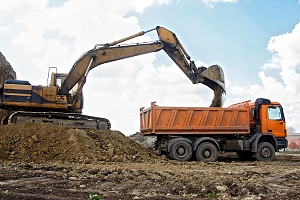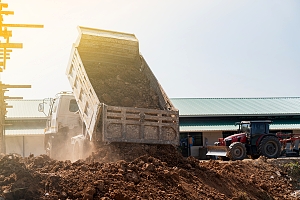When undertaking a home construction project, one often overlooked aspect is the accurate estimation of the required dirt quantity. Unlike more straightforward materials like lumber or insulation, dirt presents a unique challenge due to its fluid nature.
In this comprehensive guide, we delve into the intricacies of estimating fill dirt amounts, the importance of choosing the right type, and practical methods to ensure a successful construction project.
The Challenge of Estimating Dirt Quantities
 Estimating the necessary dirt quantity is a crucial step in project planning. While materials like lumber or nails have standardized measurement units, dirt, measured in cubic yards, requires a specific understanding for accurate calculations. The challenge lies in its less tangible and fluid nature, making precise estimations vital to staying within budgetary constraints and project timelines.
Estimating the necessary dirt quantity is a crucial step in project planning. While materials like lumber or nails have standardized measurement units, dirt, measured in cubic yards, requires a specific understanding for accurate calculations. The challenge lies in its less tangible and fluid nature, making precise estimations vital to staying within budgetary constraints and project timelines.
Identifying the Right Type of Dirt
Choosing between fill dirt and topsoil is a pivotal decision that directly impacts the success of your construction project. Each type has distinct characteristics and serves specific purposes. Understanding the unique properties of fill dirt, located beneath the topsoil layer and primarily composed of hard, rocky material, versus the nutrient-rich topsoil, aids in making informed decisions regarding the stability and function of your project’s foundation.
Fill Dirt: Stability for Construction Foundation
Fill dirt, characterized by its lack of organic compounds and nutrients, is ideal for tasks such as leveling surfaces before construction, filling landscaping holes, and creating stable slopes. Its stability and resistance to shifting make it a foundational choice for construction projects, ensuring long-term durability.
Topsoil: Nourishment for Vegetation
Topsoil, the outermost layer rich in organic compounds, is crucial for sustaining vegetation. While prone to shifting, it provides essential nutrients for plant growth. Often used in conjunction with fill dirt, topsoil creates a balanced foundation, supporting both the stability required for construction and the nourishment needed for planted areas.
Estimating Dirt Quantities: A Step-by-Step Approach
Estimating the required dirt quantity involves understanding cubic yards, the standard unit of measurement for this material. A cubic yard equals 27 cubic feet, and a grasp of this conversion is essential for accurate estimations.
Here’s a step-by-step approach to estimating dirt quantities for your project:
- Convert Dimensions to Feet: Convert dimensions, such as depth, length, and width, from inches to feet for a consistent unit of measurement.
- Calculate Cubic Feet: Multiply the converted dimensions to find the number of cubic feet of dirt required.
- Determine Cubic Yards: Divide the cubic feet by 27 to determine the required amount of dirt in cubic yards.
Utilizing Online Calculators for Simplicity
If the calculations seem overwhelming, numerous online dirt calculators are available with a quick Google search. These tools simplify the estimation process, ensuring accuracy and saving valuable time in project planning.
Planning Ahead: Key to a Successful Project
In the intricate realm of home construction projects, the linchpin of triumph lies in meticulous planning. Strategic foresight, comprehensive assessments, and accurate estimates of all project materials are the guiding principles that pave the way for a successful endeavor. Within this framework, the estimation of dirt quantities emerges as a critical component, requiring careful consideration and a proactive approach.
The Imperative of Accurate Estimates
Accurate estimates form the bedrock of any well-executed construction project. Each material, from the tangible elements like lumber and nails to the less tangible but equally significant component of dirt, demands a thorough understanding of its required quantity.
While estimating dirt amounts may present its unique challenges due to its fluid nature, armed with precise measurements and a keen comprehension of the specific type of dirt needed, you can set forth on your home project with unwavering confidence.
Navigating the Challenge of Dirt Estimation
Estimating dirt quantities goes beyond mere numbers; it involves deciphering the intricacies of cubic yards, understanding the differences between fill dirt and topsoil, and factoring in the specific needs of your construction project.
Despite the challenges posed by the fluidity of dirt, a diligent approach to calculations and a clear understanding of the project’s requirements empower you to navigate this challenge with finesse.
The Cautionary Approach: A Buffer for Success
 In the realm of construction, the unexpected can often become a recurring theme. Hence, adopting a cautionary stance becomes paramount. It’s not just about meeting the estimated dirt quantity but ensuring a buffer to prevent potential delays.
In the realm of construction, the unexpected can often become a recurring theme. Hence, adopting a cautionary stance becomes paramount. It’s not just about meeting the estimated dirt quantity but ensuring a buffer to prevent potential delays.
This foresight acknowledges the dynamic nature of construction projects, providing you with a safety net against unforeseen circumstances. Erring on the side of caution by having a slightly surplus amount of dirt can prove to be the differentiating factor between a seamless construction process and potential setbacks.
Confidence in Execution
Armed with meticulous planning, accurate estimates, and a prudent approach, you embark on your home construction project with a sense of assurance. The comprehensive understanding of your project’s intricacies, including the specific dirt requirements, allows you to proactively address challenges, make informed decisions, and keep the project on course.
Reach Out For Northern Virginia Surplus Dirt Pickup
In the event of surplus dirt post-project, our hassle-free pickup service at Dirt Connections offers a convenient solution. Contact us for more information and elevate your construction project planning to new heights. Understanding dirt quantities is not just about numbers; it’s about laying a solid foundation for the success of your construction venture.









































